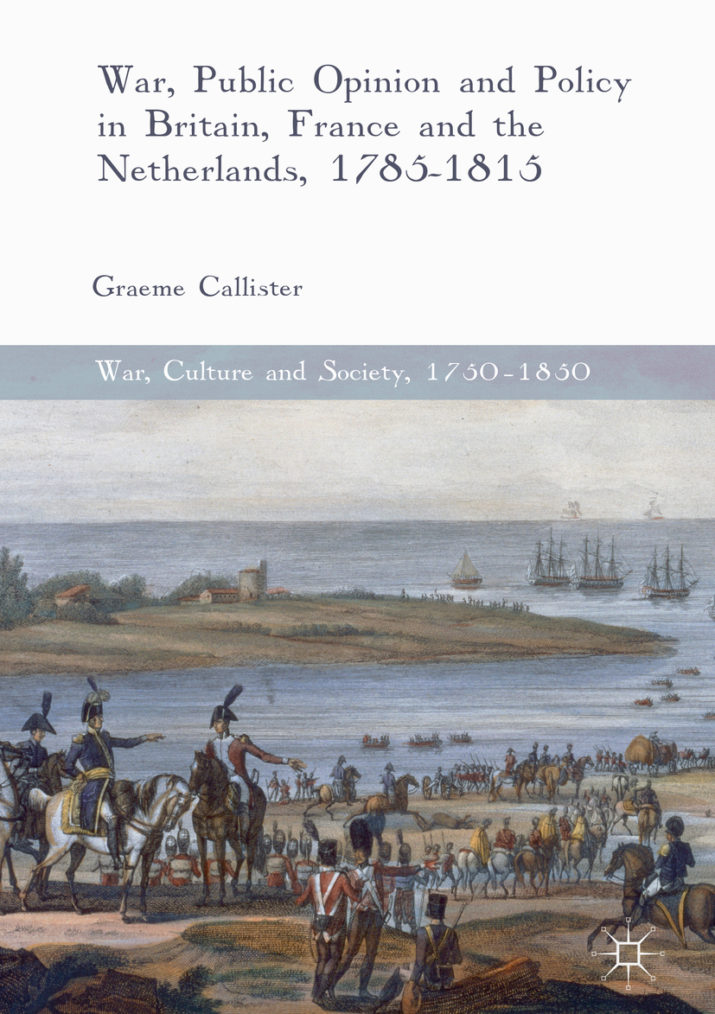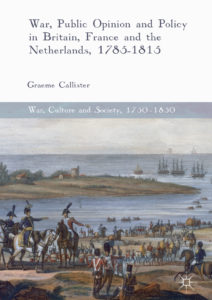
War, Public Opinion and Policy in Britain, France and the Netherlands, 1785-1815 by Graeme Callister
 Callister’s book is an ambitious study as it examines the interplay of public opinion, national sentiment, and foreign policy during the period 1785-1815, not only in one, but in three countries. This choice is motivated by his conviction that the Netherlands, Britain, and France were strongly interconnected at that time. To provide proof of these connections, the book starts with a survey of Anglo-Franco-Dutch relations during the seventeenth and eighteenth centuries, when the French kings, Louis XIV and Louis XV, threatened the other countries, and when the Dutch Stadholder, William III, became king of England during the so-called Glorious Revolution. At that time, the Netherlands were a powerful country, but they declined in the middle of the eighteenth century, as a consequence of the wars against France and of the growing power of Great Britain. Once a mighty Republic, the small country became a weak entity in the European balance of powers.
Callister’s book is an ambitious study as it examines the interplay of public opinion, national sentiment, and foreign policy during the period 1785-1815, not only in one, but in three countries. This choice is motivated by his conviction that the Netherlands, Britain, and France were strongly interconnected at that time. To provide proof of these connections, the book starts with a survey of Anglo-Franco-Dutch relations during the seventeenth and eighteenth centuries, when the French kings, Louis XIV and Louis XV, threatened the other countries, and when the Dutch Stadholder, William III, became king of England during the so-called Glorious Revolution. At that time, the Netherlands were a powerful country, but they declined in the middle of the eighteenth century, as a consequence of the wars against France and of the growing power of Great Britain. Once a mighty Republic, the small country became a weak entity in the European balance of powers.
The following chapters concentrate on the links between public opinion, national identity, and foreign policy for the three countries. Each one is treated separately. First to be studied are the Netherlands, which are at the center of this study. It is understandable, since they were an important issue for France and Great-Britain. First described are public opinion and national identity; then the impact of these on foreign policy. In other words, the author is looking for “potential popular input into foreign policy” (3).
For Callister, “public opinion” means the received ideas and national stereotypes one country nurtures about another or aboutitself. He distinguishes a latent public opinion, formed by secular representations, and an active opinion, originating from actual experiences. Here, we are indeed in the field of imagology, which concentrates on auto-images and hetero-images. The self would be constructed by the image we have of the other. And this statement is playing a role even in foreign policy.
But there is a problem with this definition of public opinion: it is not really a popular opinion, since the eighteenth century citizens were not all aware of these representations, even though they received more and more access to printed matter and politics. So, Arthur Young, who was travelling through France during the French Revolution, was surprised not to find reading clubs and newspapers anywhere – as were in England. The French, indeed, knew nothing about the contemporary events, even about the Parisian ones. From time to time, Callister must recognize that these representations are above all those of the elites (296). It is unfortunate that he did not read Roger Chartier’s illuminating book on the cultural origins of the French Revolution and on this precise topic. Callister’s bibliography is not limited however, and he has read plenty of studies on public opinion, public sphere, and readership. But as far as the bibliography is concerned, many books and articles are quoted that do not appear in the text and in the notes. Callister seems to prefer quoting archives than reminding earlier studies on the issues he is tackling. This is not really kind for his fellow scholars. Moreover, I am not sure that he understands rightly what some of his French colleagues are writing. I suspect some misinterpretations on pages 189-191, for instance. His vision of French policy is not always accurate either, as in Carnot’s case, whose position was far more qualified than told in this book. Had he known Virginie Martin’s Ph-Thesis on diplomacy and revolution, he would have come to more subtle conclusions.
However, one can understand that Callister could not quote each title he has read, since there are too many. Many are also the topics he is focusing onto: from national stereotypes to public sphere, cultural changes, and foreign affairs. But he succeeded to articulate them in a clear-cut narrative. The question is more whether stereotypes and received ideas are capable of influencing foreign policy. And whether interesting conclusions can be drawn from such a study? One thing is certainly true: foreign policy did not always have first-hand information and was forced to adopt ideas politicians thought to be correct. As far as the Netherlands are concerned, both the French and British believed that they still were mighty and rich, that their navy was strong and their sailors were valuable, and allies or enemies behaved consequently. In 1811, however, Napoleon was still impressed by what he saw through his own eyes and planned to invade England in the following years, with Dutch help. He had no time to further explore this project because of the 1812 Russian disaster. Following their convictions, some politicians were also misled. So, Grenville believed that the Dutch wanted to get rid of their French alliance and would revolt against the patriots if his troops and Russian allies invaded the Netherlands. This did not happen – in contrast with the other sister republics of Revolutionary France. In this case, it is difficult to know if one must speak of “latent” or “active” opinion. Probably, Grenville had obtained information about Dutch dissatisfaction from his diplomats and agents in the Netherlands, whereas he still believed in a latent Dutch anglophilia (00).
At last, Callister concludes, “foreign policy was formed from a complex interaction of strategic necessities, political ideology, personal experience and the expectations created by the underlying themes of latent public opinion” (292). And he is right. Received ideas never overrode other reasons, and “public opinion offered no prescriptive plan for what politicians should do with such information” (292). There were diplomats and agents too, who understood very well that it was not so easy. Their role has still to be studied. How important were their advices in decision-making? Virginie Martin contends that they were crucial. Perhaps a new challenge for Callister!
Altogether, Callister’s work is surely valuable and offers a good survey of foreign policy in France, Britain, and the Netherlands. But as his topic is wide-ranging, some issues need to be qualified: this is only possible in a narrower framework. Interesting too is the reminder that opinion-forming does not always originate from experience and agency, but from received ideas and national stereotypes. This must not be forgotten in a century. which is far from progressive and still draws its certainty from hackneyed sources.
Reviewed by Annie Jourdan, University of Amsterdam/ Paris I-Sorbonne
War, Public Opinion and Policy in Britain, France and the Netherlands, 1785-1815
By Graeme Callister
Publisher: Palgrave Macmillan
Hardcover / 348 pages / 2017
ISBN: 978-3-319-49589-7
Published on September 5, 2018.




